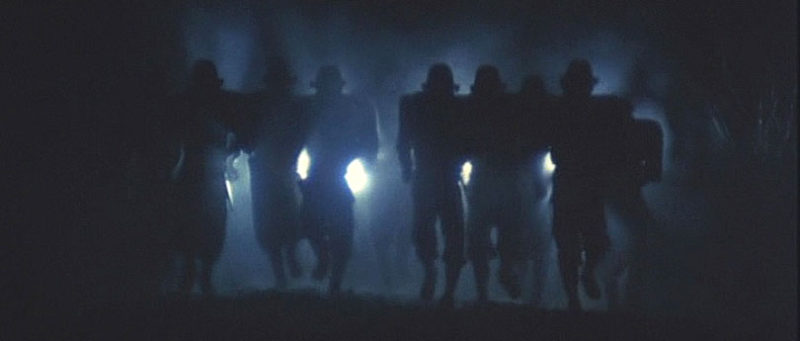
Kage no Gundan (aka Shadow Warriors) is one of the most famous, and prolific, properties in ninja media history. The Sonny Chiba TV show was the shinobi Magnum PI — a smash hit that lasted several seasons and defined TV ninja in Japan for the 1980s. But the 1979/80 film that actually launched the property has little or nothing to do with that show when it comes to artistic execution and overall tone. Despite coming from the mind of Castle of Owls director Eiichi Kudo (13 Assassins, The Great Killing) and having Toei studio money behind it, Kage no Gundan: Hattori Hanzo (aka Hattori Hanzo: Samurai Shadow and simply Shadow Warriors) stands as an utterly aberrant oddity on multiple fronts — at times brilliant, at others baffling and approaching abstract arthouse, save for a mid-movie love letter to that decidedly non-arthouse of entities — American football.
Let’s talk what is perhaps the weirdest ninja movie ever, and certainly the most head-scratching single scene in the entire genre.
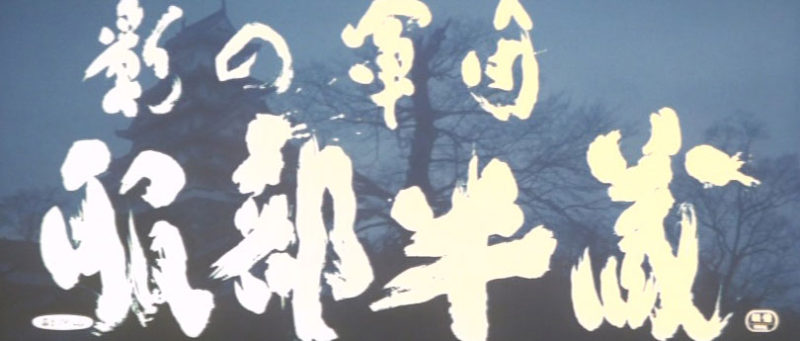
Strange Shadows
Japan wasn’t particularly looking for a high-profile ninja movie in the late 1970’s. The 1960s, a decade defined by noir-ish black-and-white credible ninja movies, was long in the rearview mirror, and shinobi had largely migrated to kid’s properties in various mutated forms, or been replaced by tangental archetypes like feudal crime squads on primetime TV. Movie studios were trying to jump on the Star Wars bandwagon at panic speed, with laser-propelled martial arts epics like Kadokawa’s Legend of the Eight Samurai on the horizon. The worldwide 80s ninja boom was a few years off still (although gaining pre-momentum in the U.S.), so the idea of giving a pile of money to Kudo to bring the chain-mail hooded Hattori Hanzo to the big screen was either way too late, or so visionary in its earliness it missed the boat in the other direction. Somebody in some wing of the development process must have hoped for a mainstream-friendly hit that would meet somewhere in the middle of martial arts exploitation and historical military epic. What they got was outright weirdness.
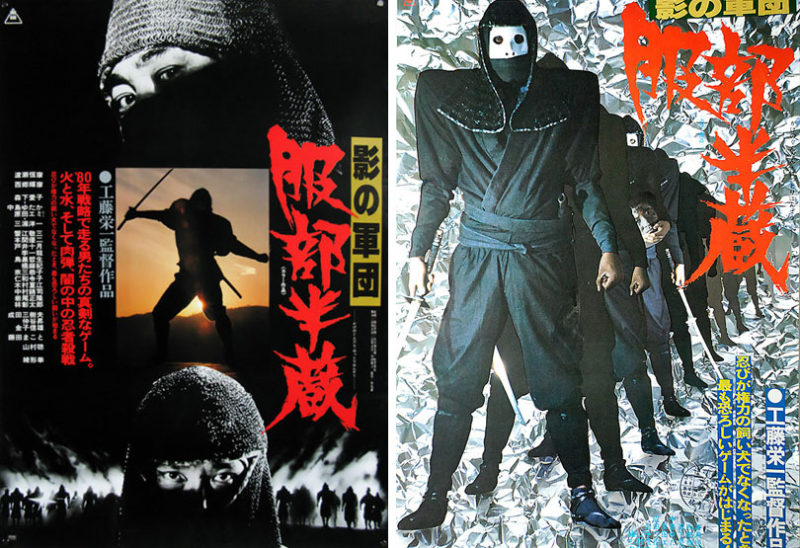
A crucial character in myriad films and shows, the historical legendary ninja Hattori Hanzo, and his descendants of identical namesake, are about 50/50 portrayed as heroic stalwarts of justice working unsung from the shadows, or as sinister master spies commanding an army of shinobi secret police. Here, Hanzo (Tsunehiko Watase) is a morose and bitter former warrior on the down-and-out, using his skills to steal just enough to live and pay rent at the bottom of a sake bottle. He and his band of not-so-merry men are despised by authorities and criminals alike, clinging to existence in the claustrophobic streets of Edo.
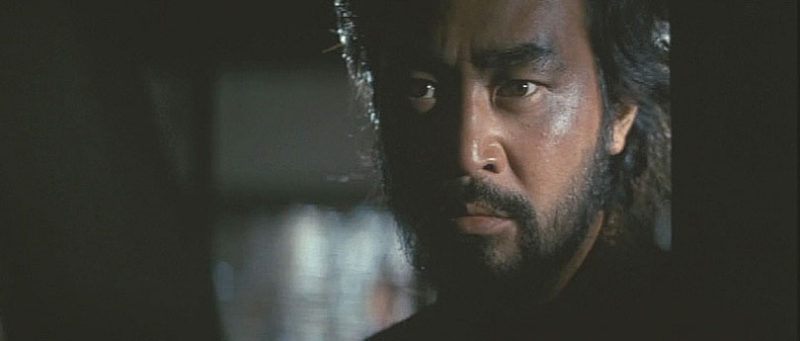
So sets the tone of the film — pessimistic, nihilistic and downright dour. Hanzo’s band of highly skilled Iga refugees are utterly irrelevant amidst period-set but modern-feeling urban congestion — no war to fight, no cause to either support or subvert. The skies are perpetually grey, the lighting drab, and in such a diffuse spectrum there can be no real shadows.
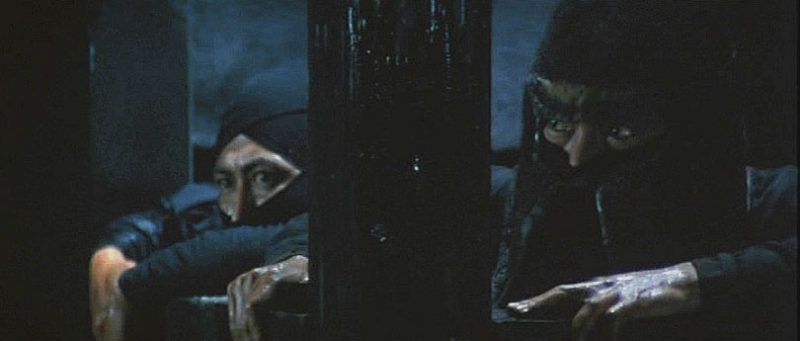
So when an on-the-lam Hanzo is manipulated into the political machinations of others, its almost a relief. He’d normally want no part of rescuing the kidnapped child-heir of the recently deceased Shogun Iemitsu, or assassinating one lord to help another, but backed into a corner by new laws exiling ronin from the city by force, and pressured by his more noble-minded brother (Teruhiko Saigô), he finds himself donning the signature family armored hood and entering the ninja life once again.
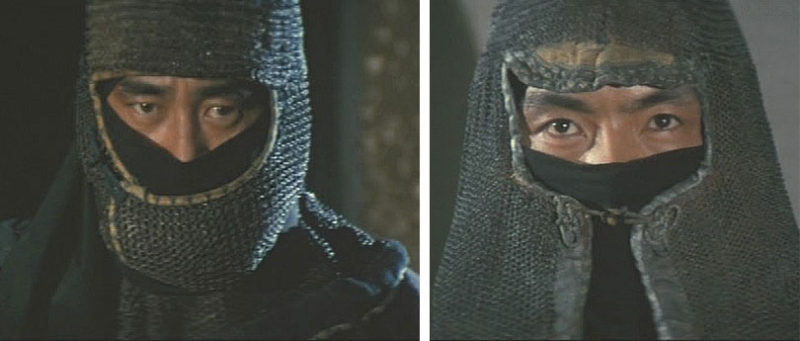
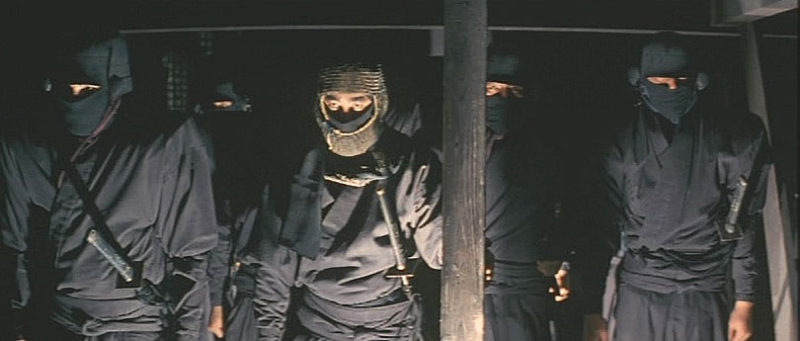
Once he does, the lights become harshly bright and the shadows they create intensely dark, as director Kudo really goes to work. The cinematography is brilliant. Ninja are shot through vertical obstacles like pillars and trees, a constant series of prison-like bars symbolically driving home how trapped they are in a fight beyond their control.
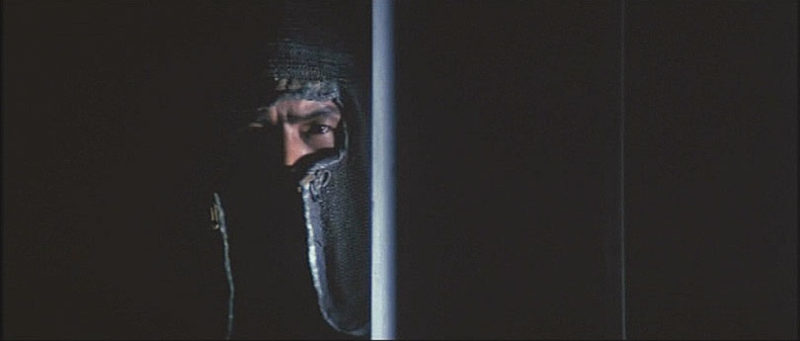
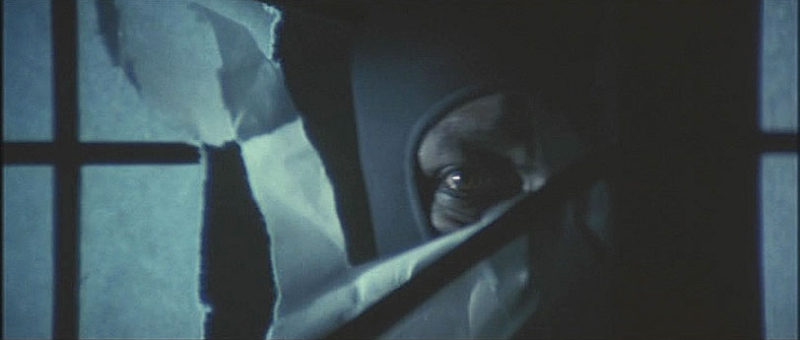
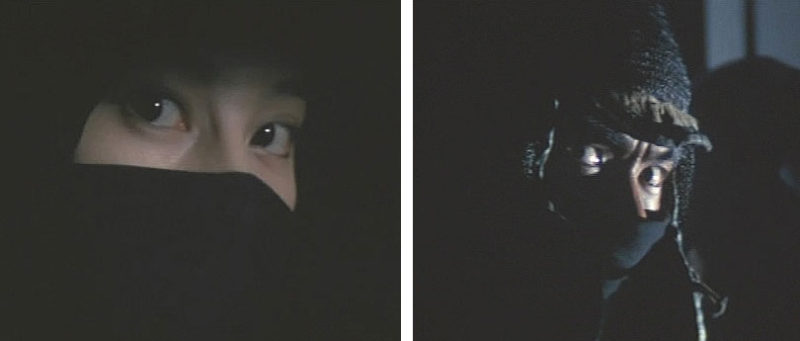
Characters are often illuminated only by the narrowest of light beams, shards of brightness both escaping from and exposing the shadows. The mastery of foreground, background and subject, as well as a command of chiaroscuro that mocks the color film stock this movie was shot on rivals the likes of Samurai Spy.
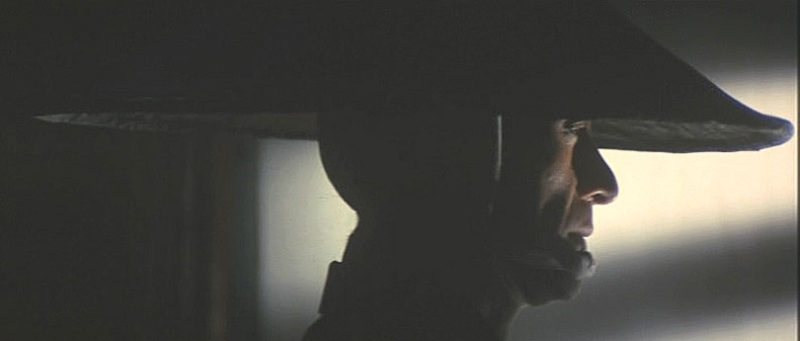
Kudo doesn’t stop defying genre expectations there, though. In fact, he starts defying the sensibilities of the first part of his own movie… with vigor. In what began as a very real, almost too down-to-earth setting, he starts injecting bizarre villains for the Hanzos, such as a fire-breathing tar-man who takes command of a force of white theatre-masked Koga cannon-fodder. Hanzo himself is as perplexed as we are as viewers, almost meta-aware he’s wandered into a surreal movie himself.
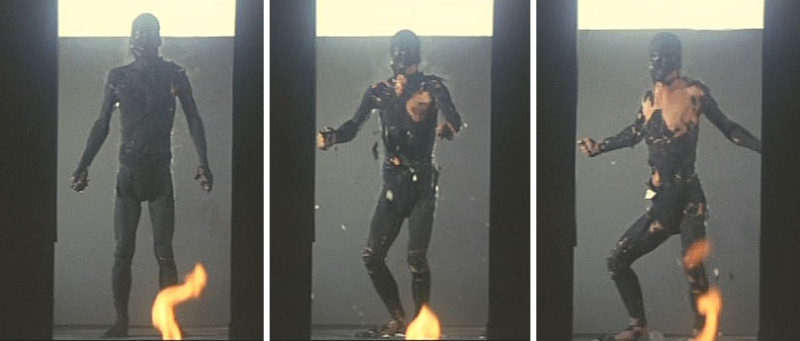
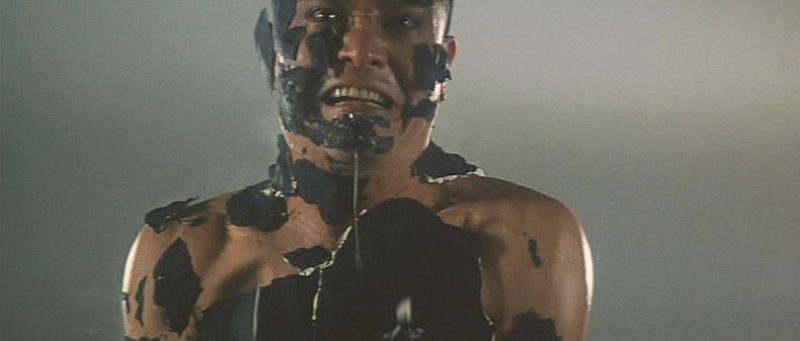
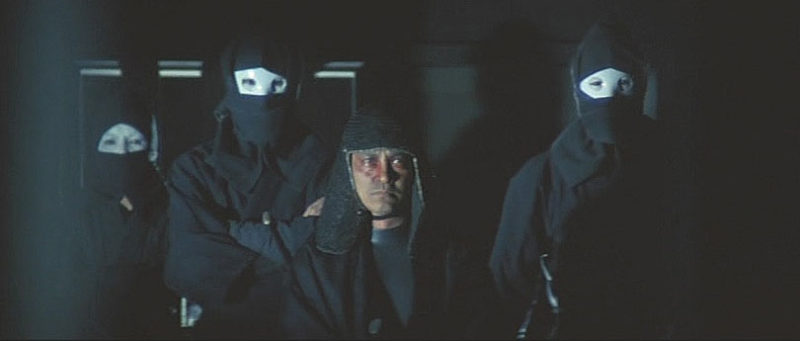
Also strange in this film is how brutal it is on its female characters. Despite being superbly shot, they are treated like utter shit — devalued rape victims, agency-bereft victims in the way of the men’s warrior codes. For a seemingly enlightened film with a lot to say artistically, no one behind the camera had any use for women here.
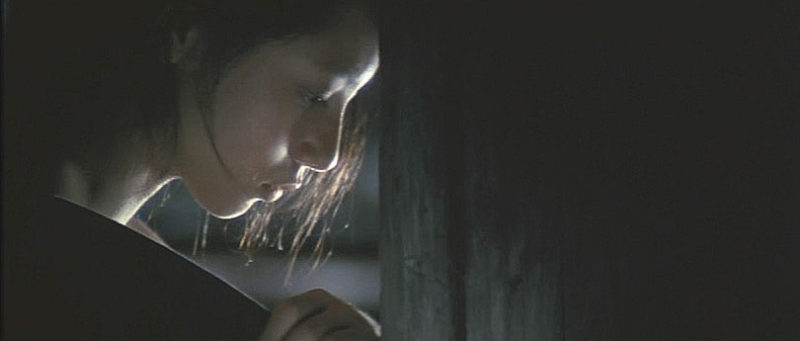
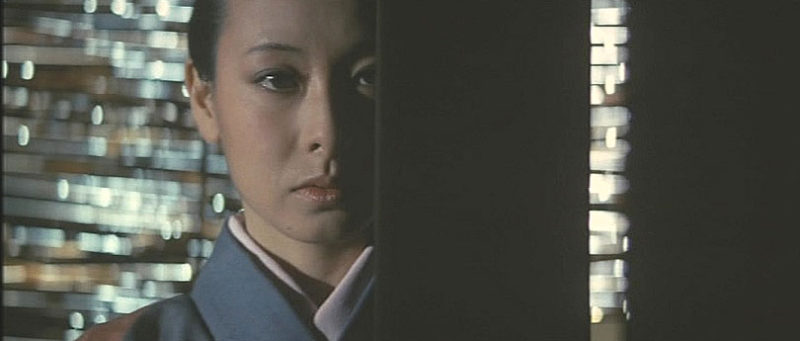
And then they start playing football.
Literally. I’m not kidding. Fucking football.
A mid-film clash between rival ninja squads in the woods starts out pretty normal. But then you start to notice things like the bamboo under-armor worn by Hanzo’s men is starting to look more and more like shoulder pads.
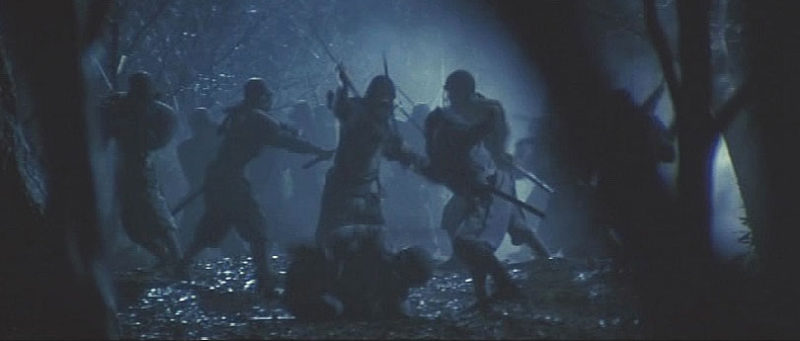
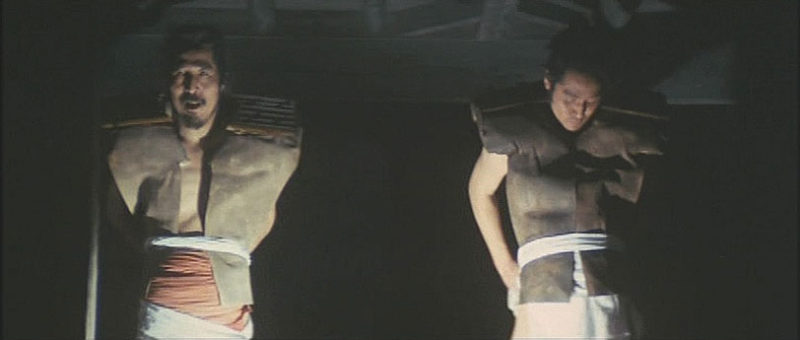
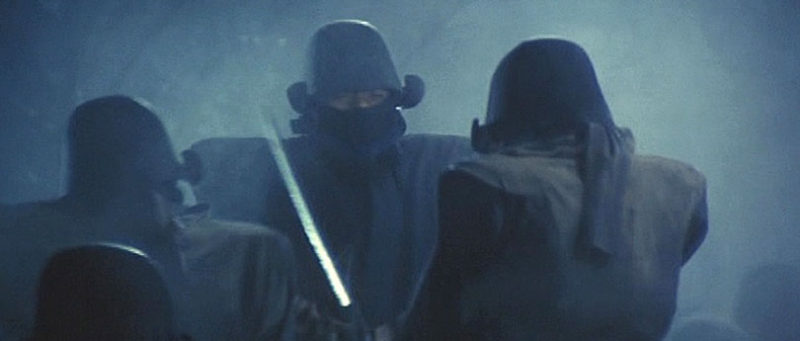
And then the two sides, now in linear formations facing each other as if across the gridiron, huddle up, make some whispered plan, then break into formation of three-point down-linemen stances.
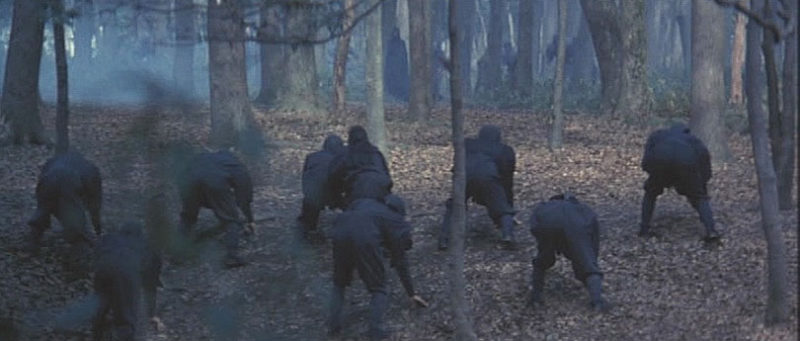
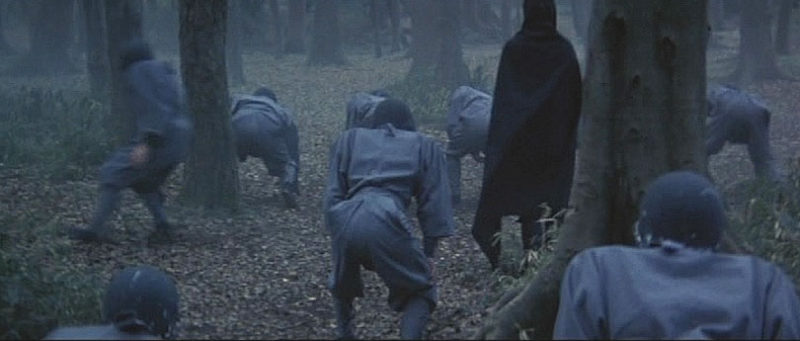
And just as you’re saying to yourself, OK, this gag has gone on long enough, Kudo really screws with the audience by switching up the helmets from shot to shot, angle to angle, with actual outright football gear!
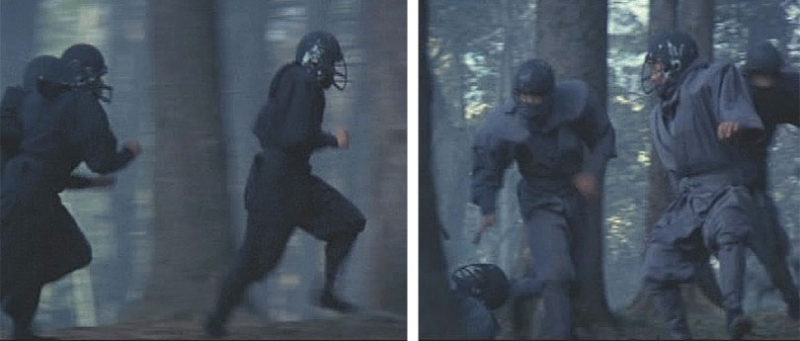
Hanzo makes various runs at the opposing team, never able to break through, and oh Kudo, you’re sooooo brilliant in your meta-commentary and in referencing this exotic (for Japan) American sport as an allegory and its all just so sardonic and art-house-as-hell and you’re just such an artiste you might as well be a snooty French prick WHAT THE HELL ARE YOU DOING YOU MADE CASTLE OF DAMN OWLS AND NOW YOU’RE PULLING THIS BULLSHIT WHAT THE HOLY CRAP I CAN’T SCREAM LOUD ENOUGH!!!
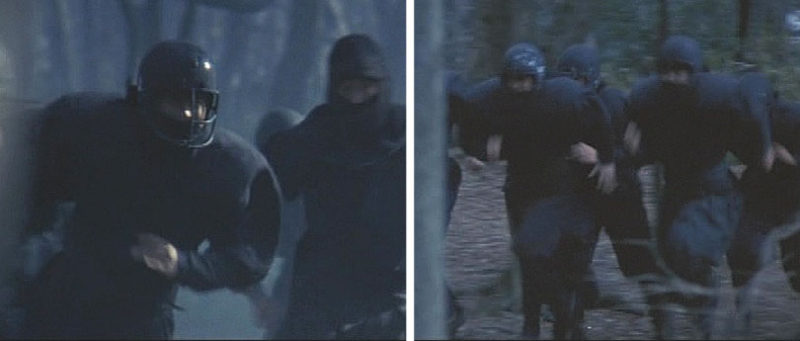
And so what if the cinematography, blocking and editing are utterly brilliant, Eiichi, you’ve ruined the legacy of this nearly forgotten film by overshadowing all its other merits with this idiotic football gag and man do I need to take a breath and calm down you are going to be the death of me!
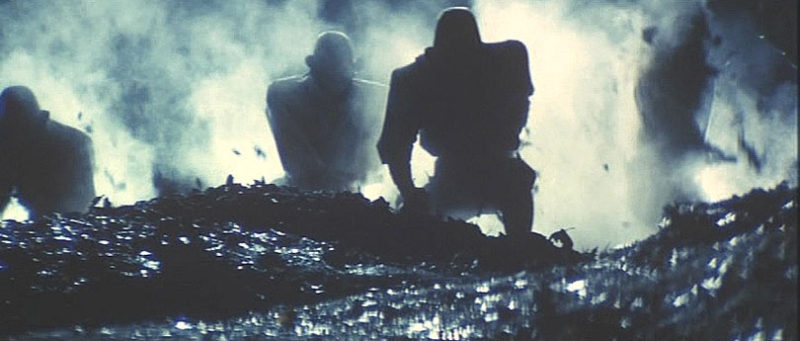
Alright, I’m OK now…
Shadow Warriors eventually shifts gears back to its core and culminates with the bothers Hanzo infiltrating a castle infested with weirdo ninja in what is possibly the finest set-piece battle in the history of the idiom. Kudo’s mastery of portraying black-clad warriors fighting in largely unlit rooms is remarkable. As they ascend floor after floor of hooded jobbers, the setting becomes increasingly claustrophobic and the melee more and more nerve-wracking. Some perfectly executed (and rather historically genuine) castle sabotage leads to a massive set collapsing around wild sword fight choreography, and some absolutely A-level miniature work brings it all crashing down.
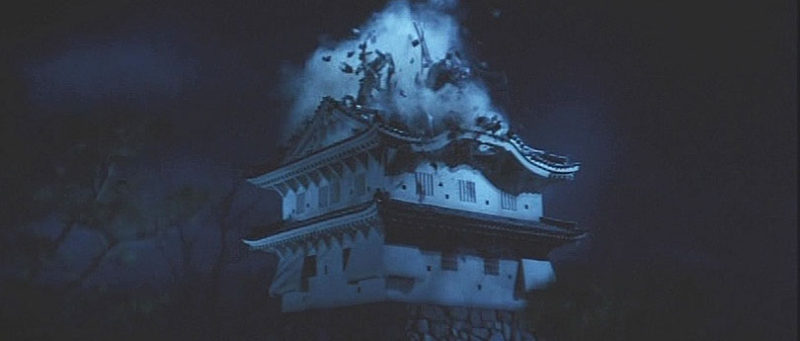
Despite some truly heroic efforts just to survive the battles in this film, our “hero” Hanzo ends up being unsympathetic to the end. Sure, he eventually hoods-up and does the right thing, but only after a lot of good people die waiting for him to do so, and pretty much too late to make a huge dent in the evil of the world. When the dust settles, he sheds his ninja gear in a familiar denouement, but its almost like rather than the ‘escaping-the-shadow-life’ triumph other films close with, this guy’s just disgusted, and relieved that so many ninja are now dead he’s free to escape his own trade and no one will be around to notice.
This is when, to some, the film seems like Kudo’s post-mortem commentary on the genre.
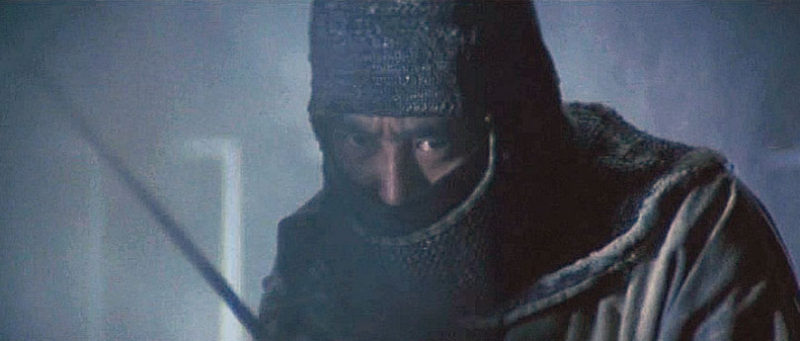
But I myself find it harder than others to dismiss KnG:HH as maybe a weird chapter of Kudo’s life where he was lampooning his own work or snubbing his nose at an old movement, simply because for all the utterly strange stuff in there, when Shadow Warriors’ ninja stuff is good, it is SOOOOO GOOOOD! Right up there with anything filmed back in the 60s craze.
Why, how, and for who?
What a difference a decade and a half made for Eiichi Kudo’s ninja. 1964’s Castle of Owls was easily one of the best three ninja movies ever made, and its rock solid story arc that spanned decades was a core strength. But KnG:HH has no such spine, and is essentially a tableau film — a quilt of genre-informed, but nevertheless downright odd, scenes strung together, with a satisfying narrative or emotional character arc for the protagonist forgotten in the assembly.
The film has three credited screenwriters, which must have contributed to it’s multiple personality disorder. Masahiro Shimura was a multi-exploitation-genre journeyman, Takayuki Yamada was a veteran of a couple of Zatoichi films, but Kôji Takada was a 60s ninja boom powerhouse, penning such classics as Yagyu Bugeicho, Kagemaru of Iga and The Ninja Hunt, before moving on to the likes of Crimson Bat and eventually Sonny Chiba’s Streetfighter flicks. I have to think the superb shinobi aspects of this film are his doing, and maybe one of the other guys was the football fan, but who the hell knows.
To be a fly on the wall of the development of this thing. Wow…
I’m not entirely sure who the audience was supposed to be for this film. Teens who idolized heartthrob Raizo Ichikawa’s ninja in the 60s, who now 10-15 years later had entered the workforce and were utterly bitter about how disappointing real life turns out to be? Jaded chambara enthusiasts looking for new lows of manic depression? Ahead-of-their-time ninja-maniacs looking for a jump-start to the 80s boom? Investors stirring up interest for an NFL expansion team based in Iga or Koga?
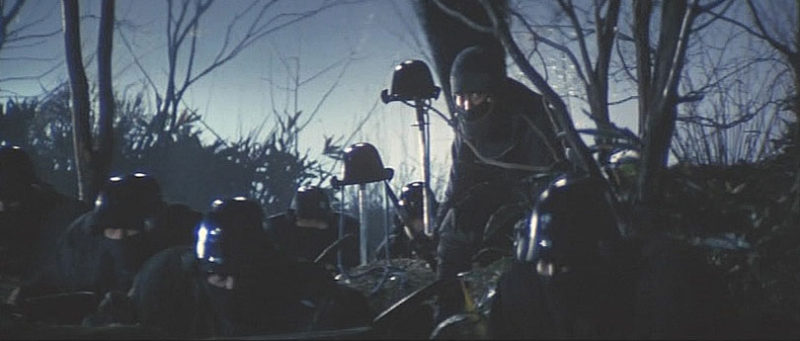
KnG is “revisionist” to its genre, much in the vein of revisionist Westerns like McCabe and Ms. Miller or Heaven’s Gate and war films like Play Dirty or Bridge at Ramagen. Like all those, it sometimes confuses bleakness, fatalism and ugliness for gritty realness and authenticity. This movie is a bleak take on an already bleak genre, trying to out-shadow a decade of black and white ninja noir. It stumbles on its own cynicism, which to some will come off like an auteur’s disdain for the material, or a handcuffed director stuck on a project he didn’t want and was messing with the studio as much as he was the audience.
If you’re a fan of Chiba’s much better-known TV series, this precursor is a must-watch for curiosity if nothing else, but don’t expect the same stunt-driven punch or plucky heroics. An American equivalent would be Robert Altman’s original M*A*S*H film and the better-known mega-hit TV version that followed — one a subversive piece of black humor whose surface details (the camp, choppers, PA system plot device, character names) were the only things that made it into the much more digestible and publicly palatable cleaned-up version that had years and years more legs.
Some side notes on costumes and weaponry
For starters, you will never see a better fashion show of chain mail over-hoods in one film ever, so if that’s your thing, KnG:HH is outright porn.
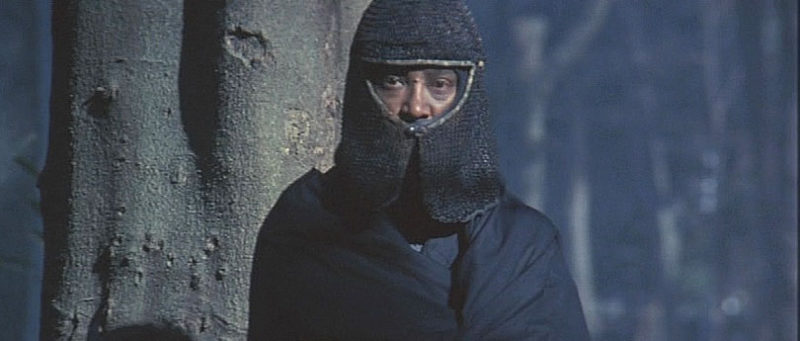
Secondly, this is probably the only vintage Japanese ninja movie to feature the right-out-of-mail-order stereotypical ninja-to that became cinematic gospel in the 80’s. Yes, specialized short, straight swords were used in the early Shinobi-no-mono films by a few characters, but the transition to the proprietary (and literally trademarked) nigh-requisite ninja-to made famous by Sho Kosugi was not really a linear one. Despite having some precedence in books and museum displays, the straight-bladed, square-guarded signature blades were just never the choice of studio prop-makers or anime and manga artists (we wrote about this pointlessly controversial topic ad nauseam years agoas has the excellent Sho Kosugi: The Ninja site).
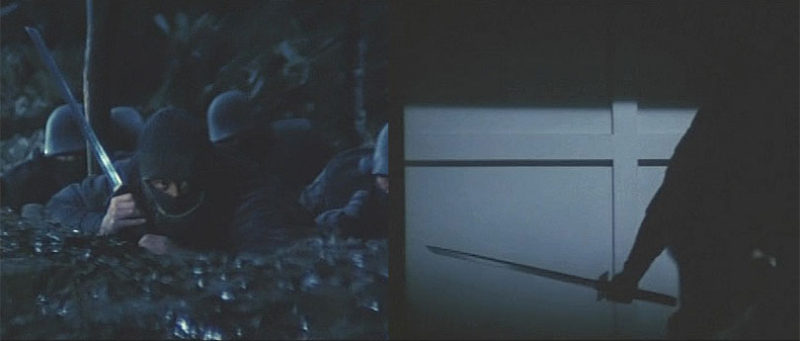
Now, before we all pat this film on the back for an attempt at alleged credibility, note that one of the uses of this storied ‘official’ blade is against another ninja using a Chinese three-sectional staff… indoors. So yeah, there’s your credibility.
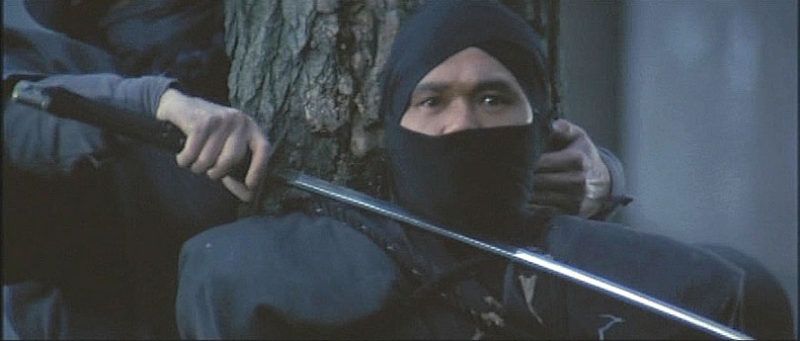
Kudo’s prop crew also took a stance against throwing stars, with kunai-like knives preferred, AND I personally applaud the frequent use of the for-some-reason-too-rarely-seen incendiary torch shuriken, amongst other clever infiltration and sabotage tools.
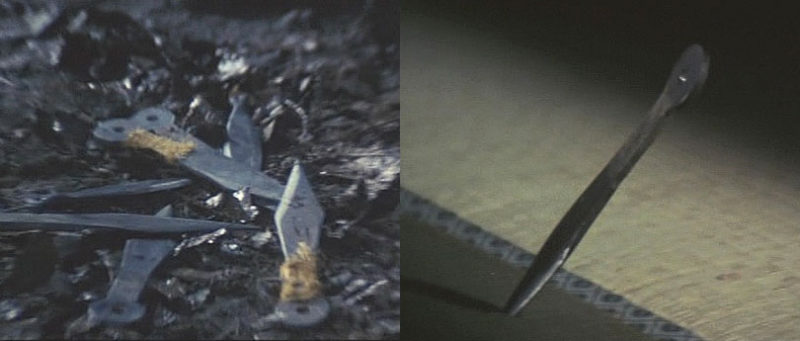
But it’ll always be known for the football…
Kage no Gundan: Hattori Hanzo, languishing it its own obscurity, remains either the punctuation on a sentence long since assumed finished (almost like The Hunted was a decade out of its time here), OR a false start on the new craze that was to come. It has some striking craft and remarkable advances on the genre, yet is utterly defined by a single scene that damns it to notorious status.
But did the football scene damn it to obscurity as well?
I have a feeling this movie might be an unsung hero of the American ninja craze. Think 1979, 1980 when it would have been on Japanese screens. Where was Sho Kosugi? Just signing on to Cannon’s Enter the Ninja production team? Weighing his options to move to the States? The movie is worth a rewatch with Kosugi in mind. The end fight is a cornucopia of killing blow posing and hooded glares that would be common in his visual vocabulary a few years later. And he would of course adopt those straight swords as gospel, with the mail order catalogs following in force.
Such a film, during the explosion of home video and nascent cable TV channels needing movies to fill their schedules, would seem IDEAL for import. Had the same team that adapted the Lone Wolf & Cub films into Shogun Assassin given this movie the same treatment, it would have blown our damned minds! But in this alternate reality world where we got a synth-drenched English dub of this film, would the producers have completely cut out the ludicrous football fight, knowing how even more silly it would have come off for Americans?
Conjecture and fantasy aside, KnG:HH should be a lot better known than it is, and the fact that all its merits are completely eclipsed by a single defining scene has to be a factor in keeping such a remarkable ninja movie in the shadows.
Keith J. Rainville — January 2019
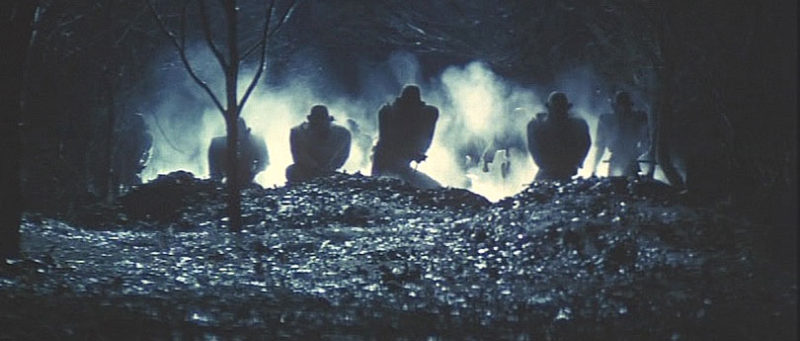
Further reading:
Here’s a nice flyer for the film’s opening
Get a close look at the hood-centric poster at Film on Paper
Paghat the Ratgirl, always the pioneer, reviewed both the film and the TV series years ago
Lard Biscuit really hated this movie
Midnight Eye has an excellent bio on Eiichi Kudo
